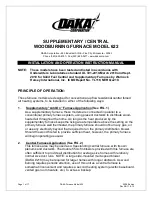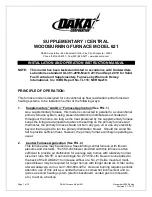
17
IMPORTANT NOTE: When pressure testing gas supply
lines at pressures greater than 1/2 psig (14 inch W.C.),
the gas supply piping system must be disconnected
from the furnace to prevent damage to the gas control
valve. If the test pressure is less than or equal to 1/2
psig (14 inch W.C.), close the manual shut-off valve.
High Altitude Application
The installation of this furnace at altitudes above 2,000
feet must meet the requirements of the International
Fuel Gas Code or local codes. High altitude conversion
of this furnace depends on the installation altitude and
heating value of the gas (at sea level) from your local
gas utility.
NOTE:
At high altitudes, the heating value is
always lower than heating value at sea level.
The *XC furnace is shipped from the factory with orifi ces
and gas regulator settings for natural gas operation at sea
level. At 2,000 feet, this appliance needs to be derated 4%
per 1,000 feet of altitude. For example, the input needs to
6
4
2
UPFLOW FURNACE
1
See
Note “B”
7
See
Note “B”
Right Side Entry
Left Side Entry
1
7
4
See
Note “A”
See
Note “A”
3
9
5
8
9
3
5
6
2
Figure 19. Typical Gas Connection
ITEM # and COMPONENT
(1) Automatic Gas Valve
(w/ manual shut-off)
(2) Burner Assembly
(3) Dripleg
(4) Elbow
(5) Ground Joint Union
(6) Manifold
(7) Pipe Nipple (8 inch)
(8) Plug
(9) Shut - Off Valve
NOTE A:
Some utilities require Shut- Off Valve to be 4 to 5 feet above fl oor.
NOTE B:
Inducer assembly omitted for clarity of pipe installation.
be reduced 8% at 2,000 feet, 12% at 3,000 feet, etc. This
deration is in reference to the input rate and gas heating
value at sea level.
WARNING:
The reduction of input rating necessary for high
altitude installation may only be accomplished
with factory supplied orifi ces. Do not attempt
to drill out orifi ces in the fi eld. Improperly
drilled orifi ces may cause fi re, explosion,
carbon monoxide poisoning, personal injury
or death.
From 2,000 to 5,000 feet, deration may be performed by
adjusting the manifold pressure on the gas valve as shown
on page 20. Above 5,000 feet, it is necessary to change
both the orifi ce and manifold pressure. Table 11 (page 29)
contains the manifold pressure and orifi ce sizes to use at
various altitudes for natural gas installations.












































